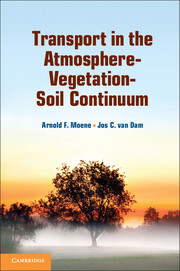Book contents
- Frontmatter
- Contents
- Preface
- 1 The Atmosphere-Vegetation-Soil System
- 2 Available Energy: Net Radiation and Soil Heat Flux
- 3 Turbulent Transport in the Atmospheric Surface Layer
- 4 Soil Water Flow
- 5 Solute Transport in Soil
- 6 Vegetation: Transport Processes Inside and Outside of Plants
- 7 Combination Methods for Turbulent Fluxes
- 8 Integrated Applications
- 9 Integrated Models in Hydrology and Meteorology
- Appendix A Radiation
- Appendix B Thermodynamics and Water Vapour
- Appendix C Dimensional Analysis
- Appendix D Microscopic Root Water Uptake
- Appendix E Crop Factors for Use with Makkink Reference Evapotranspiration
- Answers
- List of Main Symbols
- References
- Index
7 - Combination Methods for Turbulent Fluxes
Published online by Cambridge University Press: 05 June 2014
- Frontmatter
- Contents
- Preface
- 1 The Atmosphere-Vegetation-Soil System
- 2 Available Energy: Net Radiation and Soil Heat Flux
- 3 Turbulent Transport in the Atmospheric Surface Layer
- 4 Soil Water Flow
- 5 Solute Transport in Soil
- 6 Vegetation: Transport Processes Inside and Outside of Plants
- 7 Combination Methods for Turbulent Fluxes
- 8 Integrated Applications
- 9 Integrated Models in Hydrology and Meteorology
- Appendix A Radiation
- Appendix B Thermodynamics and Water Vapour
- Appendix C Dimensional Analysis
- Appendix D Microscopic Root Water Uptake
- Appendix E Crop Factors for Use with Makkink Reference Evapotranspiration
- Answers
- List of Main Symbols
- References
- Index
Summary
In Chapter 3 a number of methods were presented that can be used to determine the atmospheric fluxes of the surface energy and water balance: sensible and latent heat flux. Those methods were based solely on the use of data regarding wind, temperature and humidity: either the fluctuating parts of the signal (eddy-covariance method) or the mean values: vertical gradients or differences (similarity theory).
In this chapter we not only use our knowledge on the turbulent fluxes, as dealt with in Chapter 3, but also combine it with the energy balance equation (Chapters 1 and 2) and information on the vegetation (Chapter 6). First the Bowen ratio method is discussed in Section 7.1. Next the Penman–Monteith equation that describes the transpiration from vegetation is dealt with in Section 7.2. Finally, simplified estimates for evapo(-transpi)ration are given in Section 7.3 and dewfall (inverse evaporation) is discussed in Section 7.4.
The term “combination methods” in the title of this chapter has two different connotations:
In general, the term “combination methods” refers to methods that combine the energy balance equation with information on turbulent transfer (all methods in this chapter).
In a more restricted sense, the term “combination equation” refers to the Penman method (and derived methods) that combines the effects of two factors that determine evaporation (see Farahani et al., 2007 ). These are available energy (represented by the “radiation term”) and atmospheric demand (ability of the atmosphere to remove water vapour, represented by the “aerodynamic term”). In this restricted sense, the term refers only to the methods discussed in Section 7.2.
- Type
- Chapter
- Information
- Transport in the Atmosphere-Vegetation-Soil Continuum , pp. 252 - 277Publisher: Cambridge University PressPrint publication year: 2014



